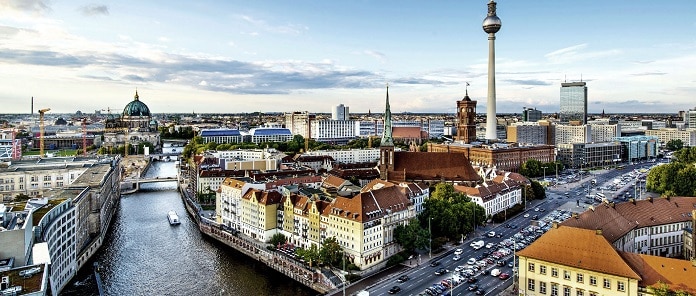Berlin is one of Europe’s oldest and most historic cities. It has seen more history in the past century alone than many others worldwide have in their lifetime. And while its history has been challenging, the city has persevered and become a major capital for not only 3.5 million people, but also art. There are innumerable reasons to come to this city, but here are the main top 10 places to visit when traveling to Berlin.
1. Berlin Wall

Needless to say, this is Berlin’s most famous historical asset. While the wall was been gone for over 2 decades, remnants of it do remain. There are stretches still to be seen, and the areas where the wall was formerly standing have been marked by a double row of cobblestones that people can follow. This runs for 5.7km/3.5 miles. There are walking tours, bike tours and a more advanced tour, the Mauerguide, which uses a small computer to give you information on places of interest as you walk by them. Checkpoint Charlie, the main crossing point between East and West Berlin can still be seen also.
2. Jewish Museum
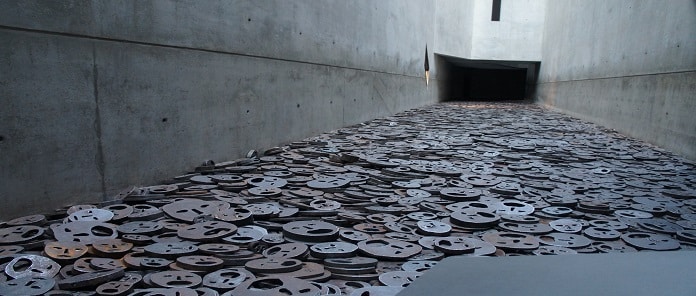
Berlin’s Jewish museum has been open to the public since 2001. It was designed by Daniel Libeskind, who has nicknamed his design “Between the Lines”, to signify the tension of Jewish/German history. The building has 2 inscribed lines of history and thought incorporated into the design, one is straight and broken, and the other is winding. Whenever the two lines meet, there is a void. The museum covers 14 historical periods of Jewish-German relations over the past 2,000 years. In direct contrast to the Memorial to the Murdered Jews of Europe, this museum has absolutely no right angles in its design.
3. Memorial to the Murdered Jews of Europe

Also located right by the Brandenburg gate, the bluntly named Memorial to the Murdered Jews of Europe is over 200,000 square feet/19,000 square meters. The memorial itself is gray stone slabs that are perfectly aligned, but alternate in height, so that no two are the same. Overall, there are 2,711 of them. The memorial is designed to look like a graveyard, but the slabs are completely blank, without any names or dates inscribed on them. The ground is undulating, so that when people walk through the memorial, it gives a disorientated feeling. Many critics feel the memorial is far too abstract, and without knowing the title, it would be impossible to know what the memorial was designed for.
4. Berlin Cathedral
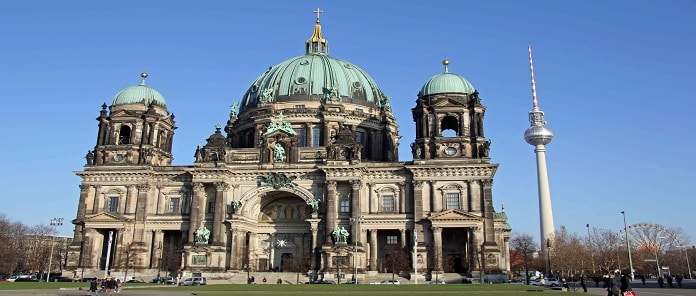
The Berlin Cathedral (Berliner Dom) is Berlin’s biggest Protestant church. Construction on it began in 1465, and was finally completed a mere 440 years later. The “old” part of the cathedral was constructed between 1747, and 1750. It was redesigned between 1817 and 1822 to more resemble St. Peter’s Basilica in Rome. Between 1888 and 1893, the “old” cathedral was leveled and the present “Berliner Dom” was constructed. It was heavily damaged in World War 2, and was not restored and reopened until 1993. The cathedral now houses many important works of art, has an organ with 7,000 pipes and over 90 gold plated sarcophagi, including Prussian royalty.
5. Museum Island
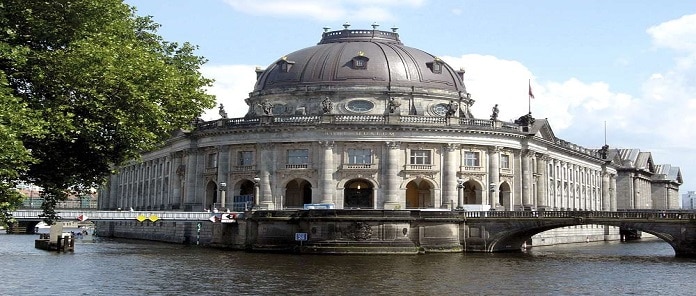
Museum island is the name of the North half of an island in the Spree river, famous for the 5 museums located there. The first of these is the Old Museum, which was built in 1823 and 1830. Originally built to house the city’s fine arts, it now houses a Greek collection as well as special exhibitions. The Old National Gallery is another museum on the island. Founded in 1861, the museum hosts a a wide variety of art, including neoclassical, Romantic, Biedermeier, Impressionist and early Modernist work. The New Museum was finished in 1855, and was damaged in WW2, only officially reopening in 2009. Inside, it houses Egyptian, prehistoric and early historical artifacts, including the iconic bust of Nefertiti. The Bode Museum was completed in 1904, reopening in 2006 after 9 years of repairs. The museum is now home to a collection of sculptures, Byzantine art, coins and medals. The last museum is the Pergamon Museum, which was completed in 1930, is divided into the antiquity collection, the Middle-East Museum, and the Museum of Islamic art.
6. Reichstag

The Reichstag is the seat of the German parliament, located right next to the Brandenburg gate. The building was completed in 1894, built with French wartime reparation money. The inscription on it, “Dem Deutschen Volke” (To the German people), was cast out of bronze taken from French cannons. After East and West Berlin were reunited, the parliament moved from Bonn, the former capital of West Germany, to the Reichstag. Renovations were completed in 1999, which included the addition of a major glass dome on the roof. There was a lot of controversy with the decision to add this, much like the addition of the glass pyramids at the Louvre, but it has now become one of the most recognizable landmarks in the city.
7. Charlottenburg Palace
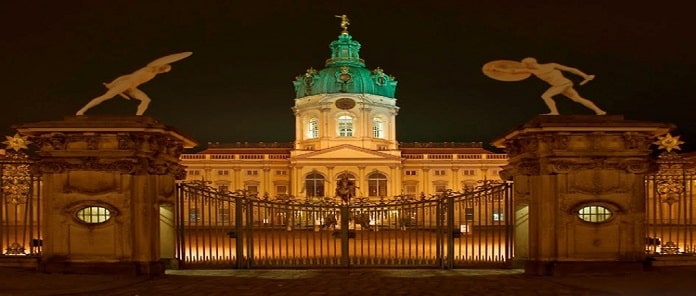
When it was originally designed, modeled after the Palace of Versailles, Charlottenburg Palace was only intended to be a small garden palace. Things got out of hand, and the palace is now 505 meters/1656 feet long. When Friedrich III became King of Prussia, a 100 year expansion of the palace began. Upon the death of Sophia Charlotte, the palace became known as Charlottenburg Palace. The gardens, originally the main focus of the area, were originally designed as a French baroque style, but were redesigned in a much less extravagant and more traditional English style.
8. Siegessaule
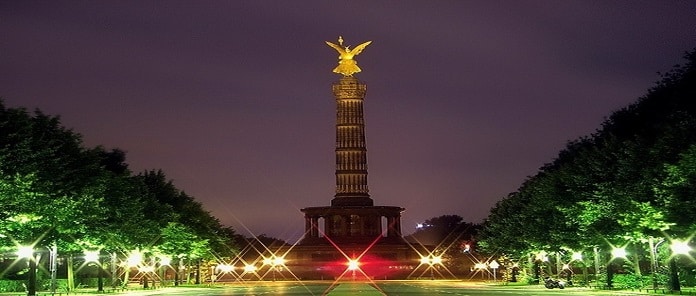
The Siegessaule, or Victory column, was designed in 1864 to commemorate Prussia’s victory in the Danish-Prussian war, but by the time it had finished construction in 1873, they had also beaten Austria and France. Victoria, the same Goddess atop the Brandenburg gate, was placed at the top of Siegessaule as well. She has been given the nickname “Golden Lizzy” (Goldelse), and the much more respectful “Chick on a Stick”. Originally located in front of the Reichstag, Nazis moved the column in 1938 to its present location, known as the “Great Star”.
9. Grunewald
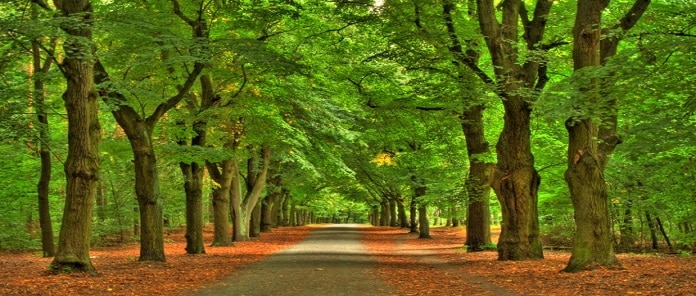
At 3,000 hectares (7,400 acres), Grunewald is the largest green area in Berlin. It is located in the West side of Berlin, and is easily accessible by S-Bahn. The river Havel runs through it, and it stretches along part of the Großer Wannsee lake, and also has a number of smaller lakes. Certain areas of the forest are off limits to the public, in order to preserve the natural wildlife, but it is, for the most part, very public. There are also guided tours of the forest available.
10. Brandenburg Gate
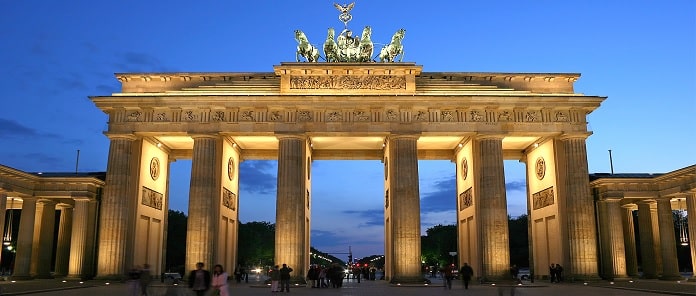
The Brandenburg gate is the only remaining gate that represented the division between East and West Berlin. The gate’s design is based on Propylaea, which was the gate to Acropolis, where the Greeks built magnificent temples. During Napoleon’s occupation of Berlin, he ordered the chariot on top of the gate be taken to Paris. After he was defeated, the chariot was taken back to Berlin. As a taunting display of victory, the plaza in front of the gate was renamed Paris square, the Goddess driving the chariot was named Victoria (Goddess of victory), and her head was changed to be looking at the French embassy. This was to signify, literally, victory over Paris.
